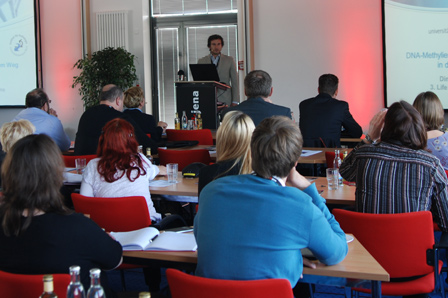News
Life Science Conference 2014: Analytik Jena Presents Patented Dual Chemistry (DC) Technology
Jena, Germany, May 15, 2014 – Analytik Jena’s two-day “Life Science Conference 2014” was concluded successfully in Jena today. Taking advantage of the occasion, the manufacturer of analytical measuring technology and life science products introduced patented dual chemistry (DC) technology, an entirely new technology platform for the isolation and purification of nucleic acids.
“The kits from Analytik Jena do not differ only marginally from competitive products, but distinguish themselves through the application of an innovative technology, for which a patent is pending. Thanks to our DC technology, Analytik Jena’s extraction kits for isolating viral DNA and RNA achieve above-average sensitivity, which leads to an improvement in the detection limit,” said Alexander Berka, General Manager of Analytik Jena’s Life Science business unit.
Until the late twentieth century, phenol and chloroform were used to extract nucleic acids – a tedious and lengthy process. Vogelstein and Gillespie created the basis for this process, which is still popular today, in 1979 with the discovery that DNA reversibly bonds with silica under certain salt conditions. Twenty years later, Boom filed a patent for a process to isolate DNA also from complex biological samples. The sample is lysed with a chaotropic buffer and DNA is absorbed in a DNA-binding solid phase. After washing the bound DNA using alcoholic buffers, it can be separated from the solid phase by adding water or a low-sodium buffer.
The most popular kits for nucleic acid isolation and purification available in the market today rely – with minor modifications – on this patent. Analytik Jena can now take credit for the next innovative step: DC technology represents an extremely efficient lyse for base materials so that much higher sample volumes can be processed than with reagents from other manufacturers. The revolutionary DC technology ensures a high binding capacity and a much higher yield. The number of steps for purifying DNA fragments from amplification reactions is reduced from 4 to 2: binding and eluting. All the other steps are eliminated due to the low salt concentration – saving a notable amount of time and labor.
The “Life Science Conference 2014” sponsored by Analytik Jena on May 14-15, 2014 was held for the third time. This event is designed to give customers and scientists from the German-speaking region the chance to learn about current scientific research topics and analytical trends in the area of biotechnology and molecular diagnostics. After only a few years, the conference series has already established itself as a platform for discussions about the life science topics and research issues of tomorrow.
More information about Analytik Jena’s DC technology can be found at www.dual-chemistry.com.

Dr. Dimo Dietrich, head of laboratory biomarkers AG, Institute of Pathology, University Hospital Bonn, spoke on the topic "DNA methylation on the way into clinical routine."

